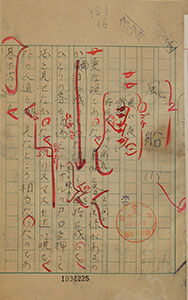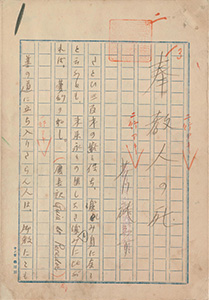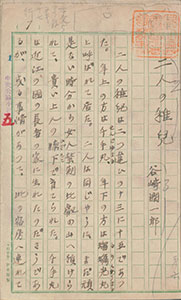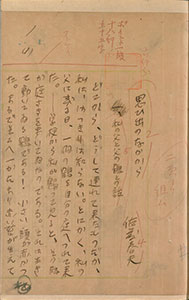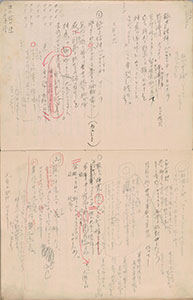Chapter 8 Writers (2)
YOSANO Akiko, 1878-1942
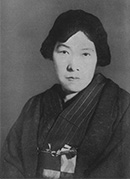 Yosano was a poet. She published her tanka in Myojo (lit. Bright Star) that Yosano Tekkan started. Her first poems, Midaregami (Tangled hair) which were written in a bold and free-spirited manner produced a sensation. She is also known for her modern translation of Genji Monogatari (Tale of Genji). She married Tekkan and raised 11 children.
Yosano was a poet. She published her tanka in Myojo (lit. Bright Star) that Yosano Tekkan started. Her first poems, Midaregami (Tangled hair) which were written in a bold and free-spirited manner produced a sensation. She is also known for her modern translation of Genji Monogatari (Tale of Genji). She married Tekkan and raised 11 children.
91 Yosano Akiko shokan, March 28, 1927[Tsurumi Yusuke Papers (Letters): 1111-1]
This is a letter which shows an aspect of Akiko being a mother. When her 26-year-old son (later Yosano Hikaru, M.D.) living in Ogikubo became sick, Akiko, living in Fujimi-cho, Kojimachi Ward, went all the way to his place and took care of him. She apologizes to Tsurumi for being rude on that day. Tsurumi Yusuke was a son-in-law of Goto Shimpei. After resigning from the Ministry of Railways, Tsurumi devoted himself to writing and giving speeches. He later became a member of the House of Representatives.
AKUTAGAWA Ryunosuke, 1892-1927
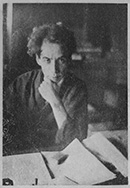 A novelist. He studied under Natsume Soseki from around the end of 1915. Hana (lit. The nose) which was published the following year was highly commended by Soseki, and Akutagawa became recognized in the literary world. His representative works include Rashomon and Kappa. He committed suicide by overdosing on sleeping pills in 1927. His death brought a great shock to society.
A novelist. He studied under Natsume Soseki from around the end of 1915. Hana (lit. The nose) which was published the following year was highly commended by Soseki, and Akutagawa became recognized in the literary world. His representative works include Rashomon and Kappa. He committed suicide by overdosing on sleeping pills in 1927. His death brought a great shock to society.
92 Hokyonin no shi, 1918[本別3-92]
An autograph manuscript by Akutagawa. It was shown in the Mita bungaku issued on September 1918. It is one of his works with theme of Christians and his representative history novel. The story is about an orphan named “Roran” (changed to “Rorenzo” when it was published as a book) who was raised in a church in Nagasaki. He suffers misunderstandings and persecution, and dies a martyr in a great fire.
TANIZAKI Jun’ichiro, 1886-1965
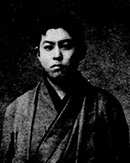 Tanizaki was a novelist. He appeared in the literary world as a member of the second Shin shicho. His works were called “diabolism” for these decadent sense of beauty. After moving to the Kansai area due to the Great Kanto Earthquake, his interest in classic culture increased and he changed his writing style. He continued to write great works and published until his later years. His representative works include Shunkin sho (The story of Shunkin) and Sasameyuki (The Makioka sisters).
Tanizaki was a novelist. He appeared in the literary world as a member of the second Shin shicho. His works were called “diabolism” for these decadent sense of beauty. After moving to the Kansai area due to the Great Kanto Earthquake, his interest in classic culture increased and he changed his writing style. He continued to write great works and published until his later years. His representative works include Shunkin sho (The story of Shunkin) and Sasameyuki (The Makioka sisters).
93 Futari no chigo, 1918[本別3-82]
This is an autograph manuscript by Tanizaki. It was carried by the Chuo koron in April 1918. Rurikomaru and Senjumaru were sent to Enryaku-ji temple at Mt. Hiei and were raised like brothers. When they grew up, they were harassed by earthly desires, especially the desire to see woman. The book is about the good and evil, abstinence and the pleasure of human beings. Tanizaki lost his mother the year before he wrote this book. The “Nyonin (woman) ” who appears in the last part of the story is said to represent the memory of his mother. There are many detailed changes on this manuscript which show Tanizaki’s obsessiveness about his writing.
SATO Haruo, 1892-1964
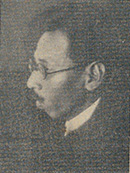 Sato was a novelist and a poet. He debuted as a romantic lyric poet but became a leading Taisho era writer with his novels, Den’en no yuutsu, Tokai no yuutsu and others. He became acquainted with Tanizaki Jun’ichiro around 1917, and Tanizaki wrote the preface to his first book Yameru sobi (year 1918, later renamed as Den’en no yuutsu). Their relationship is said to have had a great influence on each other’s works.
Sato was a novelist and a poet. He debuted as a romantic lyric poet but became a leading Taisho era writer with his novels, Den’en no yuutsu, Tokai no yuutsu and others. He became acquainted with Tanizaki Jun’ichiro around 1917, and Tanizaki wrote the preface to his first book Yameru sobi (year 1918, later renamed as Den’en no yuutsu). Their relationship is said to have had a great influence on each other’s works.
94 Omoide no naka kara, [1919][本別3-97]
This autograph manuscript was written by Sato. It has the subtitle, “Watashi no chichi to chichi no tsuru tono hanashi (lit. Story of my father and his crane)”. The story was first written for the evening edition of the Osaka Asahi Shimbun in July 1919 as a part of the novel, “Waga oitachi (lit. My upbringing)”. In the following year, it was published in a magazine San’esu under the new title with the final adjustment. The inserted material is thought to be the manuscript that appeared on San’esu. The story is about the crane his father who was a doctor brought home when Sato was a little boy. In a tranquil tone, it talks about how his father took care of the crane with affection, how the family reacted when the crane died. Later, it was included in Sato’s first collection of children’s stories, Inago no dairyoko published in 1926.
DOI Bansui, 1871-1952
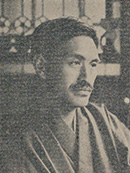 Bansui was a poet and an anglicist. After graduating from the Imperial University of Tokyo, he published his first collection of poems, Tenchi ujo, and became a great poet ranked with Shimazaki Toson. He is known as the lyric writer of “Kojo no tsuki”. He slipped out of the mainstream of the parnassus, but his translations in his later years, Iriasu (Iliad), Ojussea (Odyssey) and others are highly valued.
Bansui was a poet and an anglicist. After graduating from the Imperial University of Tokyo, he published his first collection of poems, Tenchi ujo, and became a great poet ranked with Shimazaki Toson. He is known as the lyric writer of “Kojo no tsuki”. He slipped out of the mainstream of the parnassus, but his translations in his later years, Iriasu (Iliad), Ojussea (Odyssey) and others are highly valued.
95 Iriasu, 1936-1938[本別3-63]
This is a manuscript of Homer’s Iriasu (Iliad) translated from the Original Greek by Doi Bansui. Bansui learned Greek by himself, and published a part of the Iriasu (Iliad) in the form of poetry in 1914. However, he stopped translating after he translated the first and the second books out of 24. About 20 years later, he decided to translate the rest of the books, and completed the whole poem in 1939. His translation with a total of 25 years’ work is till referred to as a milestone for the translation of Homer’s works.
The National Diet Library has three notebooks with manuscripts written around 1913, and eleven manuscripts and other items written from around 1936.
OSARAGI Jiro, 1897-1973
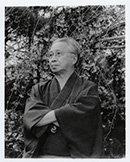 Osaragi was a novelist. He was a popular writer representing the Showa era. His well-known works include Kurama tengu, Pari moyu and Tenno no seiki. He wrote not only period novels but also great contemporary novels. He devoted himself to improving the quality of popular literature in Japan with his abundant Western knowledge.
Osaragi was a novelist. He was a popular writer representing the Showa era. His well-known works include Kurama tengu, Pari moyu and Tenno no seiki. He wrote not only period novels but also great contemporary novels. He devoted himself to improving the quality of popular literature in Japan with his abundant Western knowledge.
96 Fusen, [1955][YS1-16]
This is an autograph manuscript by Osaragi. It was serialized in the morning editions of the Mainichi Shimbun from January 20 to September 10, 1955. The story is about the people who “live as balloons (fusen) which just float with no destination” set in Japan under the Occupation by the United States. Osaragi puts special emphasis on this title and said, “I personally believe Fusen is a far better work than Kikyo (Homecoming) which is said to be my representative work (“Watashi no gendai bungaku” (Nihon meisaku jisen bungakukan, [6][KH6-59])). Manuscript paper with Osaragi’s name printed is used. There are many parts revised by Osaragi himself on the document. Parts written in red ink were added by the newspaper company.
